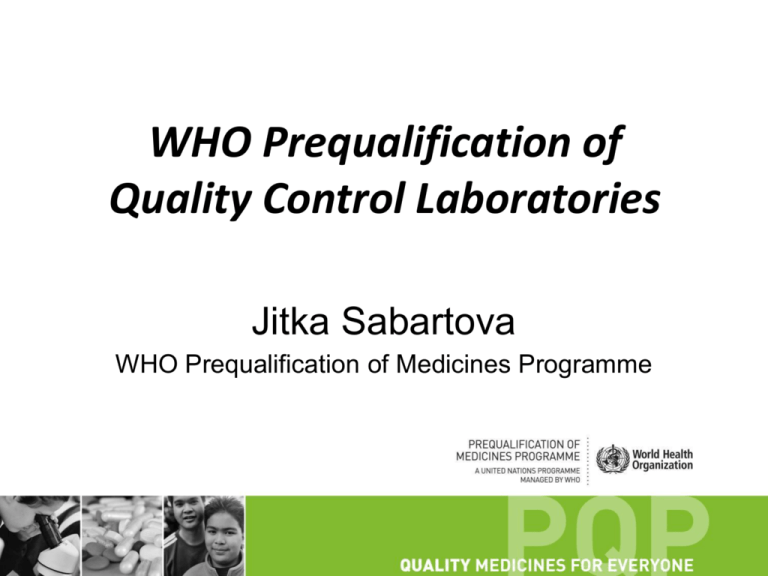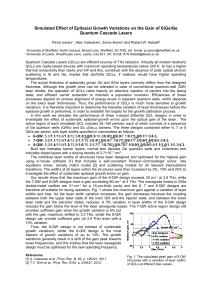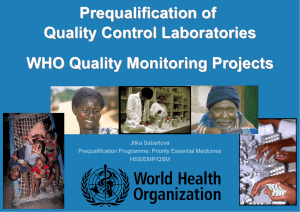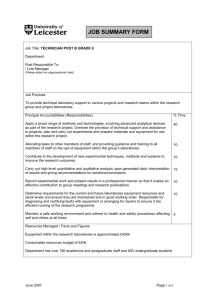WHO Prequalification of Quality Control Labs
advertisement

WHO Prequalification of Quality Control Laboratories Jitka Sabartova WHO Prequalification of Medicines Programme Objectives • Increase the access to services of QCLs that – Meet recommended standards for testing of medicines, and – Are committed to test medicines for UN agencies • Contribute to capacity building of national QCLs in developing countries (strengthening of health systems) – Technical assistance – Trainings – Guidelines 2 Prequalification procedure • Established in 2004 in cooperation with UN agencies • Procedure published in 2004, revised in 2007 and 2011 • http://www.who.int/prequal/info_general/documents/TRS961/TRS961_Annex12.pdf • Participation of a QC laboratory is voluntary – Any laboratory (private or governmental) can participate • Scope - chemical and microbiological testing (including LAL test) of medicines (vaccines, biologicals not included) • Based on the following principles – Evaluation of information submitted by the laboratory – On site inspection – Monitoring of performance of prequalified laboratory 3 Invitation for Expression of Interest • Previous invitations limited to QC laboratories in Africa, currently no regional limitation • 3rd EOI published in September 2007 – http://www.who.int/prequal/info_applicants/eoi/EOIQCLabsV3.pdf • Priority in the assessment is given to – National QC laboratories and laboratories providing testing services to the governments – QC laboratories in areas where UN agencies identify the need for quality testing 4 Steps of the procedure 1. Expression of interest − Currently free of charge 2. Submission of laboratory information file − Guidelines for preparing LIF available − Quality Manual can be submitted (amended as necessary) 3. Evaluation of submitted information − Assessment of laboratory's potential to pass successfully the inspection • Compliance WHO organizes an inspection • Gaps For a national QCL in a developing country, WHO may organize a pre-audit/ technical assistance 5 Steps of the procedure 4. Site inspection − Planned and coordinated by WHO • 2-3 days, external inspectors experienced in QC appointed (preferably from MRA) • Representative of MRA of the country where the QCL is located is invited − Compliance with WHO recommended standards • WHO Good Practices for Pharmaceutical Quality Control Laboratories – http://www.who.int/prequal/info_general/documents/TRS957/GPCL_TRS957_Annex1.pdf • WHO Good practices for pharmaceutical microbiology laboratories – http://www.who.int/prequal/info_general/documents/TRS961/TRS961_Annex2.pdf • WHO Good manufacturing practices – parts relevant to QCLs – http://www.who.int/medicines/areas/quality_safety/quality_assurance/production/en/index.html − Focus on the overall quality system in the laboratory and chemical and microbiological testing, not on individual methods only 6 Steps of the procedure 4. Site inspection (cont) − Report communicated to the laboratory • If corrective actions to be taken by the laboratory, final decision is made after their evaluation − Audit report from another authority (e.g. EDQM) • Compliance with WHO standards is evaluated and WHO inspection may not be necessary • ISO accreditation encouraged and considered but does not cover GMP aspects − If compliant, laboratory is included in the published list and WHOPIR is published • Prequalification does not guarantee future contracts for testing for UN agencies, competitive tendering usually organized 7 Steps of the procedure 5. Monitoring after prequalification − Re-inspections at a frequency based on risk assessment • − Evaluation of results from participation in proficiency testing • − WHO External Quality Assurance Scheme (EQAAS), ANSM network of Francophone African countries Brief report requested to be submitted annually • • − At least once every 3 years Summary of services provided to UN agencies, number of analysed samples, methods used, complaints received Changes with significant impact to the laboratory (key personnel, facility, equipment) and update LIF WHO may suspend or withdraw a laboratory from the list when there is evidence of noncompliance 8 9 10 Prequalified/interested QCLs (October 2014) 11 Prequalified QCLs (October 2014) Africa South Africa, RIIP+CENQAM (2005) Algeria, LNCPP (2005) South Africa, Adcock Ingram (2007) Kenya, NQCL (2008) Kenya, MEDS (2009) Tanzania, TFDA (2011) Zimbabwe, MCAZ (2014) Americas Canada, K.A.B.S. Laboratories (2010) Peru, CNCC (2010) Uruguay, CCCM (2010) Bolivia, CONCAMYT (2010) Brazil, FUNED (2011) Mexico, CCAYAC (2013) Brazil, INCQS (2014) South-East Asia India, Vimta Labs (2008) India, SGS (2011) Thailand, BDN (2012) India, Stabicon (2013) Europe France, CHMP (2008) Ukraine, CLQCM (2010) Ukraine, LPA (2010) Belgium, SGS (2011) Netherlands, Proxy (2011) Portugal, INFARMED (2011) Russia-Moscow, FSBI (2012) Belarus, RCAL (2012) Portugal, Laboratorios Basi (2013) Russia-Rostov on Don, FSBI (2014) Germany, InphA (2014) Netherlands, Synergy Health Utrecht (2014) Switzerland, Intertek (2014) Eastern Mediterranean Morocco, LNCM (2008) Pakistan, Getz Pharma (2014) Western Pacific Vietnam, NIDQC (2008) Singapore, TÜV (2009) China, NIFDC (2012) 12 QCLs in the procedure – by status (October 2014) 13 QCLs in the procedure – by region (October 2014) 14 Inspections / Pre-audits performed within QCL prequalification procedure 15 Areas of frequently found deficiencies • • • • • • • • • • • • • • SOPs not covering all laboratory activities, change control Internal audits, complaints, corrective and preventive actions Personnel - qualification, responsibilities, training programme, authorisation Premises - monitoring of storage conditions; controlled access Equipment – qualification, maintenance (not scheduled, not documented) Reference substances - use not documented, traceability to primary standards Reagents - labelling, stock management, water quality not regularly verified Records – traceability of results Back-up of electronic data Verification of validated analytical methods (pharmacopoeial, manufacturers') Procedure for atypical and out-of-specification results Data integrity Subcontracting tests Safety procedures – waste management, material safety data sheets, storage of dangerous chemicals 16 17 Capacity building • Technical assistance provided to national medicines QCLs in developing countries – 46 since 2006 (14 in 2013, 7 in 2014) – Focus on implementation of quality system, microbiology testing/lab design • Training – Training in HPLC (organized with ANSM in March 2013, Tunisia) – 6 Workshops on laboratory quality control of reproductive health products (organized with UNFPA in 2011-2013 in Tanzania, Namibia, Ghana, Thailand, Fiji, Djibouti) – WHO Interregional Seminar of QCLs involved in Prequalification in South Africa, October 2014 (training focused on observations marked in red) • WHO External Quality Assurance Assessment Scheme (EQAAS) – Dr Sabine Kopp (kopps@who.int) 18 Potential benefits of PQ for QCLs • Possibility to provide testing services to UN agencies and other organizations - financial profit • Recognition as being WHO listed laboratory • Facilitated discussions with manufacturers/customers in case of non-compliant results • Learning process improving the standards of laboratory work • In case on a national QCLs in a developing country, possibility to be assisted by WHO expert consultants and participate in WHO organized trainings 19 Thanks for your attention prequallaboratories@who.int www.who.int/prequal 20








